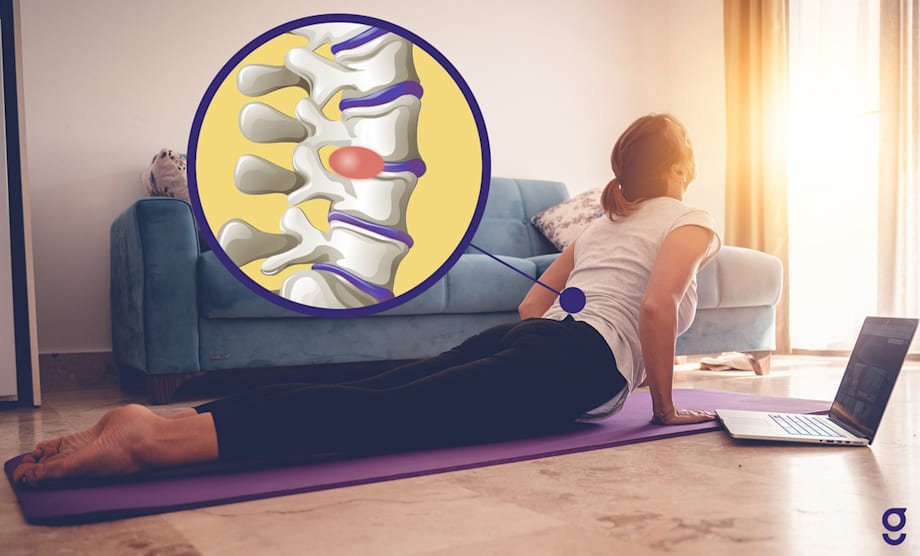A
slipped disc, also known as a herniated or prolapsed disc, is a prevalent spinal condition that can cause significant discomfort and mobility issues.
It occurs when the soft, gel-like center of a spinal disc (nucleus pulposus) protrudes through a tear in the tougher outer layer (annulus fibrosus), potentially compressing nearby nerves.
In severe cases, a slipped disc can lead to loss of bladder or bowel control, necessitating immediate medical attention.
Physiotherapy plays a crucial role in the non-surgical management of a slipped disc (herniated disc), aiming to alleviate pain, restore mobility, and prevent recurrence.
A personalized physiotherapy program typically encompasses several key components:
1. Pain Relief and Inflammation Reduction
In the initial stages, the focus is on minimizing pain and inflammation. Techniques such as hot or cold pack and gentle manual therapy may be employed. These methods help reduce muscle spasms and improve blood circulation to the affected area and helps in decreasing pain and inflammation.
2. Postural Education
Educating patients on proper posture is vital. Maintaining correct alignment during daily activities reduces undue stress on the spine. Therapists guide patients on ergonomics, emphasizing the importance of neutral spine positions during sitting, standing, and lifting.
3. Flexibility and Stretching Exercises
Gentle stretching exercises enhance flexibility and alleviate pressure on the herniated disc.
4. Strengthening Exercises
Strengthening of core and back muscles are very important and crucial part as these muscles supports the spine.
5. Aerobic Conditioning
Low-impact aerobic exercises, such as walking or swimming, improve cardiovascular health without placing excessive strain on the spine. Regular aerobic activity aids in weight management, which can alleviate pressure on spinal discs.
6. Activity Modification and Ergonomics
Therapists advise on modifying daily activities to prevent aggravation of symptoms. This includes guidance on safe lifting techniques, workspace ergonomics, and incorporating regular breaks during prolonged sitting or standing.
7. Education and Self-Management
Empowering patients with knowledge about their condition fosters adherence to therapy and encourages proactive self-management. Understanding the importance of maintaining an active lifestyle and recognizing early signs of exacerbation are integral to long-term recovery.
8.Manual Therapy Techniques
Easy-to-understand answers about diseases and conditions
A slipped disc, also known as a herniated or prolapsed disc, is a prevalent spinal condition that can cause significant discomfort and mobility issues.
It occurs when the soft, gel-like center of a spinal disc (nucleus pulposus) protrudes through a tear in the tougher outer layer (annulus fibrosus), potentially compressing nearby nerves.

In severe cases, a slipped disc can lead to loss of bladder or bowel control, necessitating immediate medical attention.
Physiotherapy plays a crucial role in the non-surgical management of a slipped disc (herniated disc), aiming to alleviate pain, restore mobility, and prevent recurrence.
A personalized physiotherapy program typically encompasses several key components:
1. Pain Relief and Inflammation Reduction
In the initial stages, the focus is on minimizing pain and inflammation. Techniques such as hot or cold pack and gentle manual therapy may be employed. These methods help reduce muscle spasms and improve blood circulation to the affected area and helps in decreasing pain and inflammation.
2. Postural Education
Educating patients on proper posture is vital. Maintaining correct alignment during daily activities reduces undue stress on the spine. Therapists guide patients on ergonomics, emphasizing the importance of neutral spine positions during sitting, standing, and lifting.
3. Flexibility and Stretching Exercises
Gentle stretching exercises enhance flexibility and alleviate pressure on the herniated disc.
4. Strengthening Exercises
Strengthening of core and back muscles are very important and crucial part as these muscles supports the spine.
5. Aerobic Conditioning
Low-impact aerobic exercises, such as walking or swimming, improve cardiovascular health without placing excessive strain on the spine. Regular aerobic activity aids in weight management, which can alleviate pressure on spinal discs.
6. Activity Modification and Ergonomics
Therapists advise on modifying daily activities to prevent aggravation of symptoms. This includes guidance on safe lifting techniques, workspace ergonomics, and incorporating regular breaks during prolonged sitting or standing.
7. Education and Self-Management
Empowering patients with knowledge about their condition fosters adherence to therapy and encourages proactive self-management. Understanding the importance of maintaining an active lifestyle and recognizing early signs of exacerbation are integral to long-term recovery.
8.Manual Therapy Techniques
Lorem ipsum dolor sit amet, consectetur adipiscing elit. Ut elit tellus, luctus nec ullamcorper mattis, pulvinar dapibus leo
Patient-centred care is about treating a person receiving healthcare with dignity and respect and involving them in all decisions about their health. This type of care is also called ‘person-centred care’. It is an approach that is linked to a person’s healthcare rights.
Aside from the treatment program, an overlooked aspect of treatment is the environment. Many people do not realize how big a factor this is for those who want to recover.
Mentorship and peer support are pivotal in creating environments that nurture personal and collective growth, learning, and success, making each feel connected and valued.

3F-78S, Peacock Court, Wave City Centre, Sector-32, Noida, Uttar Pradesh -201301